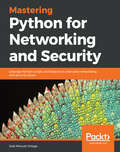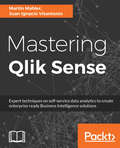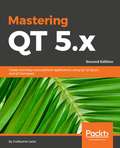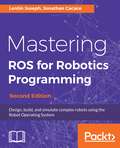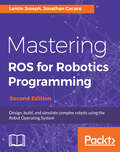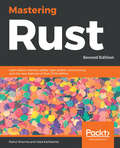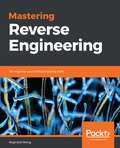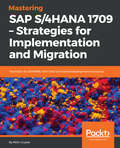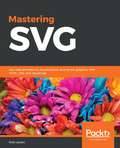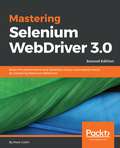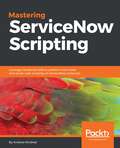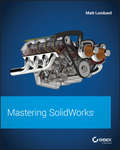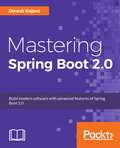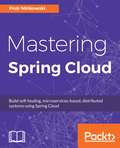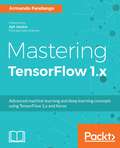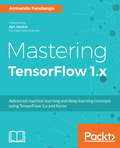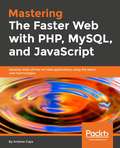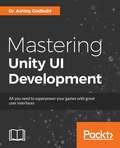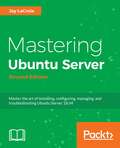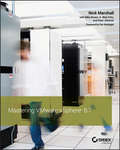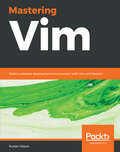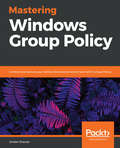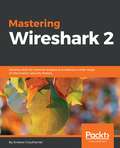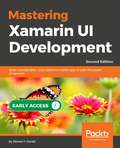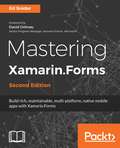- Table View
- List View
Mastering Python for Networking and Security: Leverage Python scripts and libraries to overcome networking and security issues
by Jose Manuel OrtegaMaster Python scripting to build a network and perform security operationsKey FeaturesLearn to handle cyber attacks with modern Python scriptingDiscover various Python libraries for building and securing your networkUnderstand Python packages and libraries to secure your network infrastructureBook DescriptionIt's becoming more and more apparent that security is a critical aspect of IT infrastructure. A data breach is a major security incident, usually carried out by just hacking a simple network line. Increasing your network's security helps step up your defenses against cyber attacks. Meanwhile, Python is being used for increasingly advanced tasks, with the latest update introducing many new packages. This book focuses on leveraging these updated packages to build a secure network with the help of Python scripting. This book covers topics from building a network to the different procedures you need to follow to secure it. You'll first be introduced to different packages and libraries, before moving on to different ways to build a network with the help of Python scripting. Later, you will learn how to check a network's vulnerability using Python security scripting, and understand how to check vulnerabilities in your network. As you progress through the chapters, you will also learn how to achieve endpoint protection by leveraging Python packages along with writing forensic scripts. By the end of this book, you will be able to get the most out of the Python language to build secure and robust networks that are resilient to attacks.What you will learnDevelop Python scripts for automating security and pentesting tasksDiscover the Python standard library's main modules used for performing security-related tasksAutomate analytical tasks and the extraction of information from serversExplore processes for detecting and exploiting vulnerabilities in serversUse network software for Python programmingPerform server scripting and port scanning with PythonIdentify vulnerabilities in web applications with PythonUse Python to extract metadata and forensicsWho this book is forThis book is ideal for network engineers, system administrators, or any security professional looking at tackling networking and security challenges. Programmers with some prior experience in Python will get the most out of this book. Some basic understanding of general programming structures and Python is required.
Mastering Qlik Sense: Expert techniques on self-service data analytics to create enterprise ready Business Intelligence solutions
by Juan Ignacio Vitantonio Martin MahlerMaster the capabilities of Qlik Sense to design and deploy solutions that address all the Business Intelligence needs of your organizationKey FeaturesCreate compelling dashboards and visualizations with your data by leveraging Qlik Sense's self-service modelPerform data loading and model efficient solutions with faster performance and better governanceMaster Qlik Sense’s APIs and develop powerful mashups and fantastic extensions for visualizations and other components that run across all platformsBook DescriptionQlik Sense is a powerful, self-servicing Business Intelligence tool for data discovery, analytics and visualization. It allows you to create personalized Business Intelligence solutions from raw data and get actionable insights from it.This book is your one-stop guide to mastering Qlik Sense, catering to all your organizational BI needs. You'll see how you can seamlessly navigate through tons of data from multiple sources and take advantage of the various APIs available in Qlik and its components for guided analytics. You'll also learn how to embed visualizations into your existing BI solutions and extend the capabilities of Qlik Sense to create new visualizations and dashboards that work across all platforms. We also cover other advanced concepts such as porting your Qlik View applications to Qlik Sense,and working with Qlik Cloud. Finally, you'll implement enterprise-wide security and access control for resources and data sources through practical examples.With the knowledge gained from this book, you'll have become the go-to expert in your organization when it comes to designing BI solutions using Qlik Sense.What you will learnUnderstand the importance of self-service analytics and the IKEA-effectExplore all the available data modeling techniques and create efficient and optimized data modelsMaster security rules and translate permission requirements into security rule logicFamiliarize yourself with different types of Master Key Item(MKI) and know how and when to use MKI.Script and write sophisticated ETL code within Qlik Sense to facilitate all data modeling and data loading techniquesGet an extensive overview of which APIs are available in Qlik Sense and how to take advantage of a technology with an APIDevelop basic mashup HTML pages and deploy successful mashup projectsWho this book is forThis book is for Business Intelligence professionals and Data Analysts who want to become experts in using Qlik Sense. If you have extensively used QlikView in the past and are looking to transition to Qlik Sense, this book will also help you. A fundamental understanding of how Qlik Sense works and its features is all you need to get started with this book.
Mastering Qt 5: Create stunning cross-platform applications using C++ with Qt Widgets and QML with Qt Quick, 2nd Edition
by Guillaume Lazar Robin PeneaAn In-depth guide updated with the latest version of Qt 5.11 including new features such as Quick Controls and Qt GamepadKey FeaturesUnleash the power of Qt 5.11 with C++Build applications using Qt Widgets (C++) or Qt Quick (QML)Create cross-platform applications for mobile and desktop platforms with Qt 5Book DescriptionQt 5.11 is an app development framework that provides a great user experience and develops full capability applications with Qt Widgets, QML, and even Qt 3D. Whether you're building GUI prototypes or fully-fledged cross-platform GUI applications with a native look and feel, Mastering Qt 5 is your fastest, easiest, and most powerful solution. This book addresses various challenges and teaches you to successfully develop cross-platform applications using the Qt framework, with the help of well-organized projects.Working through this book, you will gain a better understanding of the Qt framework, as well as the tools required to resolve serious issues, such as linking, debugging, and multithreading. You'll start off your journey by discovering the new Qt 5.11 features, soon followed by exploring different platforms and learning to tame them. In addition to this, you'll interact with a gamepad using Qt Gamepad. Each chapter is a logical step for you to complete in order to master Qt.By the end of this book, you'll have created an application that has been tested and is ready to be shipped.What you will learnCreate stunning UIs with Qt Widgets and Qt Quick 2Develop powerful, cross-platform applications with the Qt frameworkDesign GUIs with the Qt Designer and build a library in it for UI previewsHandle user interaction with the Qt signal or slot mechanism in C++Prepare a cross-platform project to host a third-party libraryUse the Qt Animation framework to display stunning effectsDeploy mobile apps with Qt and embedded platformsInteract with a gamepad using Qt GamepadWho this book is forMastering Qt 5 is for developers and programmers who want to build GUI-based applications. C++ knowledge is necessary, and knowing QT basics will help you get the most out of this book.
Mastering ROS for Robotics Programming, Second Edition: Design, Build, And Simulate Complex Robots Using The Robot Operating System
by Jonathan Cacace<P><P>Discover best practices and troubleshooting solutions when working on ROS <P><P>Key Features <P><P>Develop complex robotic applications using ROS to interface robot manipulators and mobile robots <P><P>Gain insight into autonomous navigation in mobile robots and motion planning in robot manipulators <P><P>Discover best practices and troubleshooting solutions <P><P>Book Description <P><P>In this day and age, robotics has been gaining a lot of traction in various industries where consistency and perfection matter. Automation is achieved via robotic applications and various platforms that support robotics. The Robot Operating System (ROS) is a modular software platform to develop generic robotic applications. This book focuses on the most stable release of ROS (Kinetic Kame), discusses advanced concepts, and effectively teaches you programming using ROS. <P><P>We begin with aninformative overview of the ROS framework, which will give you a clear idea of how ROS works. During the course of this book, you'll learn to build models of complex robots, and simulate and interface the robot using the ROS MoveIt! motion planning library and ROS navigation stacks. Learn to leverage several ROS packages to embrace your robot models. <P><P>After covering robot manipulation and navigation, you'll get to grips with the interfacing I/O boards, sensors, and actuators of ROS. Vision sensors are a key component of robots, and an entire chapter is dedicated to the vision sensor and image elaboration, its interface in ROS and programming. You'll also understand the hardware interface and simulation of complex robots to ROS and ROS Industrial. <P><P>At the end of this book, you'll discover the best practices to follow when programming using ROS. <P><P>What you will learn <P><P>Create a robot model with a seven-DOF robotic arm and a differential wheeled mobile robot <P><P>Work with Gazebo and V-REP robotic simulator <P><P>Implement autonomous navigation in differential drive robots using SLAM and AMCL packages <P><P>Explore the ROS Pluginlib, ROS nodelets, and Gazebo plugins <P><P>Interface I/O boards such as Arduino, robot sensors, and high-end actuators <P><P>Simulate and motion plan an ABB and universal arm using ROS Industrial <P><P>Explore the latest version of the ROS framework <P><P>Work with the motion planning of a seven-DOF arm using MoveIt! <P><P>Who This Book Is For <P><P>If you are a robotics enthusiast or researcher who want to learn more about building robot applications using ROS, this book is for you. In order to learn from this book, you should have a basic knowledge of ROS, GNU/Linux, and C++ programming concepts. The book is also excellent for programmers who want to explore the advanced features of ROS.
Mastering ROS for Robotics Programming: Design, build, and simulate complex robots using the Robot Operating System
by Lentin Joseph Jonathan CacaceDiscover best practices and troubleshooting solutions when working on ROSKey FeaturesDevelop complex robotic applications using ROS to interface robot manipulators and mobile robotsGain insight into autonomous navigation in mobile robots and motion planning in robot manipulatorsDiscover best practices and troubleshooting solutionsBook DescriptionIn this day and age, robotics has been gaining a lot of traction in various industries where consistency and perfection matter. Automation is achieved via robotic applications and various platforms that support robotics. The Robot Operating System (ROS) is a modular software platform to develop generic robotic applications. This book focuses on the most stable release of ROS (Kinetic Kame), discusses advanced concepts, and effectively teaches you programming using ROS. We begin with aninformative overview of the ROS framework, which will give you a clear idea of how ROS works. During the course of this book, you’ll learn to build models of complex robots, and simulate and interface the robot using the ROS MoveIt! motion planning library and ROS navigation stacks. Learn to leverage several ROS packages to embrace your robot models. After covering robot manipulation and navigation, you’ll get to grips with the interfacing I/O boards, sensors, and actuators of ROS. Vision sensors are a key component of robots, and an entire chapter is dedicated to the vision sensor and image elaboration, its interface in ROS and programming. You’ll also understand the hardware interface and simulation of complex robots to ROS and ROS Industrial. At the end of this book, you’ll discover the best practices to follow when programming using ROS. What you will learnCreate a robot model with a seven-DOF robotic arm and a differential wheeled mobile robotWork with Gazebo and V-REP robotic simulatorImplement autonomous navigation in differential drive robots using SLAM and AMCL packagesExplore the ROS Pluginlib, ROS nodelets, and Gazebo pluginsInterface I/O boards such as Arduino, robot sensors, and high-end actuatorsSimulate and motion plan an ABB and universal arm using ROS IndustrialExplore the latest version of the ROS frameworkWork with the motion planning of a seven-DOF arm using MoveIt!Who this book is forIf you are a robotics enthusiast or researcher who want to learn more about building robot applications using ROS, this book is for you. In order to learn from this book, you should have a basic knowledge of ROS, GNU/Linux, and C++ programming concepts. The book is also excellent for programmers who want to explore the advanced features of ROS.
Mastering RUST: Learn about memory safety, type system, concurrency, and the new features of Rust 2018 edition, 2nd Edition
by Rahul SharmaIf you are a developer who has a general understanding of Rust and wants to become proficient with the language, this book is for you. This book covers all the advanced features of Rust using examples that a Rust developer will find useful to advance their knowledge.
Mastering Reverse Engineering: Re-engineer your ethical hacking skills
by Reginald WongImplement reverse engineering techniques to analyze software, exploit software targets, and defend against security threats like malware and viruses.Key FeaturesAnalyze and improvise software and hardware with real-world examplesLearn advanced debugging and patching techniques with tools such as IDA Pro, x86dbg, and Radare2.Explore modern security techniques to identify, exploit, and avoid cyber threatsBook DescriptionIf you want to analyze software in order to exploit its weaknesses and strengthen its defenses, then you should explore reverse engineering. Reverse Engineering is a hackerfriendly tool used to expose security flaws and questionable privacy practices.In this book, you will learn how to analyse software even without having access to its source code or design documents. You will start off by learning the low-level language used to communicate with the computer and then move on to covering reverse engineering techniques. Next, you will explore analysis techniques using real-world tools such as IDA Pro and x86dbg. As you progress through the chapters, you will walk through use cases encountered in reverse engineering, such as encryption and compression, used to obfuscate code, and how to to identify and overcome anti-debugging and anti-analysis tricks. Lastly, you will learn how to analyse other types of files that contain code.By the end of this book, you will have the confidence to perform reverse engineering.What you will learnLearn core reverse engineeringIdentify and extract malware componentsExplore the tools used for reverse engineeringRun programs under non-native operating systemsUnderstand binary obfuscation techniquesIdentify and analyze anti-debugging and anti-analysis tricksWho this book is forIf you are a security engineer or analyst or a system programmer and want to use reverse engineering to improve your software and hardware, this is the book for you. You will also find this book useful if you are a developer who wants to explore and learn reverse engineering. Having some programming/shell scripting knowledge is an added advantage.
Mastering SAP S/4HANA 1709 – Strategies for Implementation and Migration: Transition to S/4HANA with tried and tested deployment scenarios
by Nitin GuptaLearn every aspect of SAP S/4HANA and develop the skills needed to migrate from SAP ECCKey Features● Gain insight into the implementation and configuration of SAP S/4HANA ● Design business processes with SAP Central Finance● Learn the available SAP S/4HANA deployment options in depthBook DescriptionSAP S/4HANA implementation, migration, and Central Finance are the key projects being employed across the globe, with millions of consultants working day and night to implement them. Mastering SAP S/4HANA 1709 - Strategies for Implementation and Migration will allow you to gain a virtual implementation experience, and you can follow the steps to configure the learning system as per your requirements. This book focuses on several topics; each topic is covered in detail to make you a successful SAP S/4HANA professional.You will begin by understanding SAP HANA and then move toward S/4HANA and the deployment options available to customers, including what suits various customer needs. You will then understand the impact of S/4HANA on General Ledger, Asset Accounting, and Profitability Analysis; SAP notes will also be listed when needed. As you progress through the book, you explore premigration, migration, and post-migration steps including the Near Zero Downtime strategy and learn how to implement Central Finance with and without MDG using SLT. In the concluding chapters, greenfield implementations using SAP Activate methodology will also be covered.By the end of this book, you will have learned to successfully implement SAP S/4HANA projects that are customized for your business needs.What you will learnUnderstand SAP HANA and SAP S/4HANAImplement SAP S/4HANA as a greenfield implementation with SAP Activate methodologyDiscover the hidden challenges in SAP Central Finance Migrate from ECC to S/4HANA successfully in a non-disrupted roadmapExplore the change from Classic Asset Accounting to New Asset AccountingLearn to configure General Ledger, Profitability Analysis, and ControllingApply the Near Zero Downtime strategy to migration projectsWalk through Customer Vendor Integration (CVI)Who this book is forMastering SAP S/4HANA 1709: Strategies for Implementation and Migration is for project managers, solution architects, and consultants who are planning to implement SAP S/4HANA for ERP solutions and are in the process of implementing it or are currently upgrading/migrating to it.
Mastering SVG: Ace web animations, visualizations, and vector graphics with HTML, CSS, and JavaScript
by Rob LarsenTake the plunge and develop cross-browser-compatible and responsive web designs with SVGKey FeaturesMaster the art of custom animations and visualizations with SVG, CSS, and JavaScriptCombine SVG with third-party libraries and frameworks such as React, JQuery, D3, and Snap.svg for GUI-rich appsCreate an awesome user experience with high-performance graphics for your web applicationsBook DescriptionSVG is the most powerful image format in use on the web. In addition to producing resolution-independent images for today's multi-device world, SVG allows you to create animations and visualizations to add to your sites and applications. The simplicity of cross-platform markup, mixed with familiar modern web languages, such as CSS and JavaScript, creates a winning combination for designers and developers alike.In this book, you will learn how to author an SVG document using common SVG features, such as elements and attributes, and serve SVG on the web using simple configuration tips for common web servers. You will also use SVG elements and images in HTML documents.Further, you will use SVG images for a variety of common tasks, such as manipulating SVG elements, adding animations using CSS, mastering the basic JavaScript SVG (API) using Document Object Model (DOM) methods, and interfacing SVG with common libraries and frameworks, such as React, jQuery, and Angular.You will then build an understanding of the Snap.svg and SVG.js APIs, along with the basics of D3, and take a look at how to implement interesting visualizations using the library. By the end of the book, you will have mastered creating animations with SVG.What you will learnDeliver the elements that make up an SVG image Replace your old CSS sprites with SVGUnderstand animation and data visualization with SVG are explained in pure JavaScript and using common librariesUse SVG to scale images across multiple devices easily Harness the power of CSS animations and transformations to manipulate your SVG images in a replicable, remixable wayInterface SVG with common libraries and frameworks, such as jQuery, React, and AngularWho this book is forThis book is for web developers and designers looking to add animation to their projects. Some experience with HTML, CSS, and JavaScript is required.
Mastering Selenium WebDriver 3.0: Boost the performance and reliability of your automated checks by mastering Selenium WebDriver, 2nd Edition
by Mark Patrick Leigh CollinComplement Selenium with useful additions that fit seamlessly into the rich and well-crafted API that Selenium offersKey FeaturesUnderstand the power, simplicity, and limitations of the core Selenium frameworkWrite clear, readable, and reliable tests that perform complex test automation tasksWork with ChromeDriver and GeckoDriver in headless modeBook DescriptionThe second edition of Mastering Selenium 3.0 WebDriver starts by showing you how to build your own Selenium framework with Maven. You'll then look at how you can solve the difficult problems that you will undoubtedly come across as you start using Selenium in an enterprise environment and learn how to produce the right feedback when failing. Next, you’ll explore common exceptions that you will come across as you use Selenium, the root causes of these exceptions, and how to fix them. Along the way, you’ll use Advanced User Interactions APIs, running any JavaScript you need through Selenium; and learn how to quickly spin up a Selenium Grid using Docker containers. In the concluding chapters, you‘ll work through a series of scenarios that demonstrate how to extend Selenium to work with external libraries and applications so that you can be sure you are using the right tool for the job.What you will learnProvide fast, useful feedback with screenshotsCreate extensible, well-composed page objectsUtilize ChromeDriver and GeckoDriver in headless modeLeverage the full power of Advanced User Interactions APIsUse JavascriptExecutor to execute JavaScript snippets in the browser through SeleniumBuild user interaction into your test script using JavascriptExecutorLearn the basics of working with AppiumWho this book is forIf you are a software tester or a developer with working experience in Selenium and competency with Java, who is interested in automation and are looking forward to taking the next step in their learning journey, then this is the book for you.
Mastering ServiceNow Scripting: Leverage JavaScript APIs to perform client-side and server-side scripting on ServiceNow instances
by Andrew KindredUnderstand the ServiceNow scripting and build an efficient customized ServiceNow instance Key Features Customize your ServiceNow instance according to your organization’s needs Learn to work with inbuilt JavaScript APIs in ServiceNow Take your ServiceNow experience to the next level by learning to script Book Description Industry giants like RedHat and NetApp have adopted ServiceNow for their operational needs, and it is evolving as the number one platform choice for IT Service management. ServiceNow provides their clients with an add-on when it comes to baseline instances, where scripting can be used to customize and improve the performance of instances. It also provides inbuilt JavaScript API for scripting and improving your JavaScript instance. This book will initially cover the basics of ServiceNow scripting and the appropriate time to script in a ServiceNow environment. Then, we dig deeper into client-side and server-side scripting using JavaScipt API. We will also cover advance concepts like on-demand functions, script actions, and best practices. Mastering ServiceNow Scripting acts as an end-to-end guide for writing, testing, and debugging scripts of ServiceNow. We cover update sets for moving customizations between ServiceNow instances, jelly scripts for making custom pages, and best practices for all types of script in ServiceNow. By the end of this book, you will have hands-on experience in scripting ServiceNow using inbuilt JavaScript API. What you will learn Customize your ServiceNow instance according to your organization's needs Explore the ServiceNow-exposed JavaScript APIs and libraries Discover the method for using ServiceNow scripting functions Take your ServiceNow experience to the next level by understanding advanced scripting Learn to build, test, and debug custom applications Use your customized instance efficiently with the help of best practices Who this book is for This book is targeted toward ServiceNow administrators or anyone willing to learn inbuilt JavaScript APIs used to script and customize ServiceNow instances. Prior experience with ServiceNow is required.
Mastering SolidWorks
by Matt LombardThe complete SolidWorks reference-tutorial for beginner to advanced techniques Mastering SolidWorks is the reference-tutorial for all users. Packed with step-by-step instructions, video tutorials for over 40 chapters, and coverage of little-known techniques, this book takes you from novice to power user with clear instruction that goes beyond the basics. Fundamental techniques are detailed with real-world examples for hands-on learning, and the companion website provides tutorial files for all exercises. Even veteran users will find value in new techniques that make familiar tasks faster, easier, and more organized, including advanced file management tools that simplify and streamline pre-flight checks. SolidWorks is the leading 3D CAD program, and is an essential tool for engineers, mechanical designers, industrial designers, and drafters around the world. User friendly features such as drag-and-drop, point-and-click, and cut-and-paste tools belie the software’s powerful capabilities that can help you create cleaner, more precise, more polished designs in a fraction of the time. This book is the comprehensive reference every SolidWorks user needs, with tutorials, background, and more for beginner to advanced techniques. Get a grasp on fundamental SolidWorks 2D and 3D tasks using realistic examples with text-based tutorials Delve into advanced functionality and capabilities not commonly covered by how-to guides Incorporate improved search, Pack-and-Go and other file management tools into your workflow Adopt best practices and exclusive techniques you won’t find anywhere else Work through this book beginning-to-end as a complete SolidWorks course, or dip in as needed to learn new techniques and time-saving tricks on-demand. Organized for efficiency and designed for practicality, these tips will remain useful at any stage of expertise. With exclusive coverage and informative detail, Mastering SolidWorks is the tutorial-reference for users at every level of expertise.
Mastering Spring Boot 2.0: Build modern, cloud-native, and distributed systems using Spring Boot
by Dinesh RajputLearn to develop, test, and deploy your Spring Boot distributed application and explore various best practices.Key Features- Build and deploy your microservices architecture in the cloud- Build event-driven resilient systems using Hystrix and Turbine- Explore API management tools such as KONG and API documentation tools such as SwaggerBook DescriptionSpring is one of the best frameworks on the market for developing web, enterprise, and cloud ready software. Spring Boot simplifies the building of complex software dramatically by reducing the amount of boilerplate code, and by providing production-ready features and a simple deployment model.This book will address the challenges related to power that come with Spring Boot's great configurability and flexibility. You will understand how Spring Boot configuration works under the hood, how to overwrite default configurations, and how to use advanced techniques to prepare Spring Boot applications to work in production. This book will also introduce readers to a relatively new topic in the Spring ecosystem – cloud native patterns, reactive programming, and applications. Get up to speed with microservices with Spring Boot and Spring Cloud. Each chapter aims to solve a specific problem or teach you a useful skillset. By the end of this book, you will be proficient in building and deploying your Spring Boot application.What you will learn Build logically structured and highly maintainable Spring Boot applications Configure RESTful microservices using Spring Boot Make the application production and operation-friendly with Spring Actuator Build modern, high-performance distributed applications using cloud patterns Manage and deploy your Spring Boot application to the cloud (AWS) Monitor distributed applications using log aggregation and ELKWho this book is forThe book is targeted at experienced Spring and Java developers who have a basic knowledge of working with Spring Boot. The reader should be familiar with Spring Boot basics, and aware of its benefits over traditional Spring Framework-based applications.
Mastering Spring Cloud: Build self-healing, microservices-based, distributed systems using Spring Cloud
by Piotr MińkowskiLearn how to build, test, secure, deploy, and efficiently consume services across distributed systems.Key Features- Explore the wealth of options provided by Spring Cloud for wiring service dependencies in microservice systems.- Create microservices utilizing Spring Cloud's Netflix OSS- Architect your cloud-native data using Spring Cloud.Book DescriptionDeveloping, deploying, and operating cloud applications should be as easy as local applications. This should be the governing principle behind any cloud platform, library, or tool. Spring Cloud–an open-source library–makes it easy to develop JVM applications for the cloud. In this book, you will be introduced to Spring Cloud and will master its features from the application developer's point of view. This book begins by introducing you to microservices for Spring and the available feature set in Spring Cloud. You will learn to configure the Spring Cloud server and run the Eureka server to enable service registration and discovery. Then you will learn about techniques related to load balancing and circuit breaking and utilize all features of the Feign client. The book now delves into advanced topics where you will learn to implement distributed tracing solutions for Spring Cloud and build message-driven microservice architectures. Before running an application on Docker container s, you will master testing and securing techniques with Spring Cloud.What you will learn- Abstract Spring Cloud's feature set- Create microservices utilizing Spring Cloud's Netflix OSS- Create synchronous API microservices based on a message-driven architecture.- Explore advanced topics such as distributed tracing, security, and contract testing.- Manage and deploy applications on the production environment Who this book is forThis book appeals to developers keen to take advantage of Spring cloud, an open source library which helps developers quickly build distributed systems. Knowledge of Java and Spring Framework will be helpful, but no prior exposure to Spring Cloud is required.
Mastering TensorFlow 1.x: Advanced Machine Learning And Deep Learning Concepts Using Tensorflow 1. X And Keras
by Armando FandangoWe cover advanced deep learning concepts (such as transfer learning, generative adversarial models, and reinforcement learning), and implement them using TensorFlow and Keras. We cover how to build and deploy at scale with distributed models. You will learn to build TensorFlow models using R, Keras, TensorFlow Learn, TensorFlow Slim and Sonnet
Mastering TensorFlow 1.x: Advanced machine learning and deep learning concepts using TensorFlow 1.x and Keras
by Armando Fandango Nick McClureBuild, scale, and deploy deep neural network models using the star libraries in Python Key Features Delve into advanced machine learning and deep learning use cases using Tensorflow and Keras Build, deploy, and scale end-to-end deep neural network models in a production environment Learn to deploy TensorFlow on mobile, and distributed TensorFlow on GPU, Clusters, and Kubernetes Book Description TensorFlow is the most popular numerical computation library built from the ground up for distributed, cloud, and mobile environments. TensorFlow represents the data as tensors and the computation as graphs. This book is a comprehensive guide that lets you explore the advanced features of TensorFlow 1.x. Gain insight into TensorFlow Core, Keras, TF Estimators, TFLearn, TF Slim, Pretty Tensor, and Sonnet. Leverage the power of TensorFlow and Keras to build deep learning models, using concepts such as transfer learning, generative adversarial networks, and deep reinforcement learning. Throughout the book, you will obtain hands-on experience with varied datasets, such as MNIST, CIFAR-10, PTB, text8, and COCO-Images. You will learn the advanced features of TensorFlow1.x, such as distributed TensorFlow with TF Clusters, deploy production models with TensorFlow Serving, and build and deploy TensorFlow models for mobile and embedded devices on Android and iOS platforms. You will see how to call TensorFlow and Keras API within the R statistical software, and learn the required techniques for debugging when the TensorFlow API-based code does not work as expected. The book helps you obtain in-depth knowledge of TensorFlow, making you the go-to person for solving artificial intelligence problems. By the end of this guide, you will have mastered the offerings of TensorFlow and Keras, and gained the skills you need to build smarter, faster, and efficient machine learning and deep learning systems. What you will learn Master advanced concepts of deep learning such as transfer learning, reinforcement learning, generative models and more, using TensorFlow and Keras Perform supervised (classification and regression) and unsupervised (clustering) learning to solve machine learning tasks Build end-to-end deep learning (CNN, RNN, and Autoencoders) models with TensorFlow Scale and deploy production models with distributed and high-performance computing on GPU and clusters Build TensorFlow models to work with multilayer perceptrons using Keras, TFLearn, and R Learn the functionalities of smart apps by building and deploying TensorFlow models on iOS and Android devices Supercharge TensorFlow with distributed training and deployment on Kubernetes and TensorFlow Clusters Who this book is for This book is for data scientists, machine learning engineers, artificial intelligence engineers, and for all TensorFlow users who wish to upgrade their TensorFlow knowledge and work on various machine learning and deep learning problems. If you are looking for an easy-to-follow guide that underlines the intricacies and complex use cases of machine learning, you will find this book extremely useful. Some basic understanding of TensorFlow is required to get the most out of the book.
Mastering The Faster Web with PHP, MySQL, and JavaScript: Develop state-of-the-art web applications using the latest web technologies
by Andrew CayaMake web applications run faster by using advanced PHP, SQL and JavaScript techniquesKey FeaturesUse a customized PHP stack to create efficient data-driven web applicationsEnsure seamless implementation of a JavaScript & HTML 5 CSS based frontend and PHP based backend. Learn about problem identification, best strategies, and UI design patterns as well to build a clean, fast web applicationBook DescriptionThis book will get you started with the latest benchmarking, profiling and monitoring tools for PHP, MySQL and JavaScript using Docker-based technologies. From optimizing PHP 7 code to learning asynchronous programming, from implementing Modern SQL solutions to discovering Functional JavaScript techniques, this book covers all the latest developments in Faster Web technologies. You will not only learn to determine the best optimization strategies, but also how to implement them.Along the way, you will learn how to profile your PHP scripts with Blackfire.io, monitor your Web applications, measure database performance, optimize SQL queries, explore Functional JavaScript, boost Web server performance in general and optimize applications when there is nothing left to optimize by going beyond performance.After reading this book, you will know how to boost the performance of any Web application and make it part of what has come to be known as the Faster Web.What you will learnInstall, confgure, and use profling and benchmarking testing toolsUnderstand how to recognize optimizable data structures and functions to effectively optimize a PHP7 applicationDiagnose bad SQL query performance and discover ways to optimize itGrasp modern SQL techniques to optimize complex SQL queriesIdentify and simplify overly complex JavaScript codeExplore and implement UI design principles that effectively enhance the performanceCombine web technologies to boost web server performanceWho this book is forThe audience for this book would be PHP developers who have some basic knowledge of PHP programming and Web technologies. JavaScript programming knowledge is not necessary.
Mastering UI Development with Unity: An in-depth guide to developing engaging user interfaces with Unity 5, Unity 2017, and Unity 2018
by Ashley GodboldMaster Game UI system by creating captivating user interface components with Unity 5 through Unity 2018 and C#. Learn about UI texts, images, world space UI, mobile-specific UI and much more.Key FeaturesDevelop a game UI with both technical and aesthetic considerationsUse all the UI elements provided by Unity's UI systemStep-by-step examples of creating user interface components in the top game genresBook DescriptionA functional UI is an important component for player interaction in every type of video game. Along with imparting crucial statistical information to the player, the UI is also the window through which the player engages with the world established by the game. Unity's tools give you the opportunity to create complex and attractive UIs to make your game stand out.This book helps you realize the full potential of Unity's powerful tools to create the best UI for your games by walking you through the creation of myriad user interface components. Learn how to create visually engaging heads-up-displays, pause menus, health bars, circular progress bars, animated menus, and more. This book not only teaches how to lay out visual elements, but also how to program these features and implement them across multiple games of varying genres.While working through the examples provided, you will learn how to develop a UI that scales to multiple screen resolutions, so your game can be released on multiple platforms with minimal changes. What you will learnDesign principles and patterns for laying out elements in your UITechniques that allow your UI to scale appropriately in different resolutionsHow to use automatic layouts to streamline your UI building processProperties of the Event System and how to appropriately hook events to your UI elementsAccess the components and properties of UI elements via code Implement all of Unity's built-in UI elements as well as those provided by TextMeshPro Develop key UI components that are popularly used in multiple game genresAdd visual flare to user interfaces with the use of animation and particle effectsCreate a UI that displays in the Screen Space as well as World SpaceWho this book is forThis book is for anyone keen to improve their games via a great user interface with Unity's UI system. If you're looking for a book that explains how to develop specific user interfaces or that thoroughly explains how each of the individual Unity components work, this book is for you.
Mastering Ubuntu Server: Master the art of deploying, configuring, managing, and troubleshooting Ubuntu Server 18.04, 2nd Edition
by Jay LaCroixGet up-to-date with the finer points of Ubuntu Server using this comprehensive guideKey FeaturesA practical easy-to-understand book that will teach you how to deploy, maintain and troubleshoot Ubuntu ServerGet well-versed with newly-added features in Ubuntu 18.04.Learn to manage cutting-edge technologies such as virtualization, containers, Nextcloud and moreBook DescriptionUbuntu Server has taken the data centers by storm. Whether you're deploying Ubuntu for a large-scale project or for a small office, it is a stable, customizable, and powerful Linux distribution that leads the way with innovative and cutting-edge features. For both simple and complex server deployments, Ubuntu's flexible nature can be easily adapted to meet to the needs of your organization. With this book as your guide, you will learn all about Ubuntu Server, from initial deployment to creating production-ready resources for your network. The book begins with the concept of user management, group management, and filesystem permissions. Continuing into managing storage volumes, you will learn how to format storage devices, utilize logical volume management, and monitor disk usage. Later, you will learn how to virtualize hosts and applications, which will cover setting up KVM/QEMU, as well as containerization with both Docker and LXD. As the book continues, you will learn how to automate configuration with Ansible, as well as take a look at writing scripts. Lastly, you will explore best practices and troubleshooting techniques when working with Ubuntu Server that are applicable to real-world scenarios. By the end of the book, you will be an expert Ubuntu Server administrator who is well-versed in its advanced concepts.What you will learn Manage users, groups, and permissions Encrypt and decrypt disks with Linux Unified Key Setup (LUKS) Set up SSH for remote access, and connect it to other nodes Add, remove, and search for packages Use NFS and Samba to share directories with other users Get to know techniques for managing Apache and MariaDB Explore best practices and troubleshooting techniques Get familiar with scripting Automate server deployments with AnsibleWho this book is forThis book is intended for readers with intermediate or advanced-beginner skills with Linux, who would like to learn all about setting up servers with Ubuntu Server. This book assumes that the reader knows the basics of Linux, such as editing configuration files and running basic commands.
Mastering VMware vSphere 6.7
by Mike Brown Ryan Johnson Nick Marshall G. Blair FritzMaster your virtual environment with the ultimate vSphere guide Mastering VMware vSphere 6.7 is the fully updated edition of the bestselling guide to VMware's virtualization solution. With comprehensive coverage of this industry-leading toolset, this book acts as an informative guide and valuable reference. Step-by-step instruction walks you through installation, configuration, operation, security processes, and much more as you conquer the management and automation of your virtual environment. Written by certified VMware vExperts, this indispensable guide provides hands-on instruction and detailed conceptual explanations, anchored by practical applications and real-world examples. This book is the ultimate guide to vSphere, helping administrators master their virtual environment. Learn to: Install, configure, and manage the vCenter Server components Leverage the Support Tools to provide maintenance and updates Create and configure virtual networks, storage devices, and virtual machines Implement the latest features to ensure compatibility and flexibility Manage resource allocation and utilization to meet application needs Monitor infrastructure performance and availability Automate and orchestrate routine administrative tasks Mastering VMware vSphere 6.7 is what you need to stay up-to-date on VMware's industry-leading software for the virtualized datacenter.
Mastering Vim: Build a software development environment with Vim and Neovim (02 RRP including tax)
by Ruslan OsipovMastering Vim, reviewed by Bram Moolenaar, the creator of Vim, covers usage of Vim and Neovim, showcases relevant plugins, and teaches VimscriptKey FeaturesExpert Vim and Vimscript techniques to work with Python and other development environmentAccomplish end-to-end software development tasks with Neovim and Vim pluginsUnderstand best practices for various facets of projects like version control, building, and testingBook DescriptionVim is a ubiquitous text editor that can be used for all programming languages. It has an extensive plugin system and integrates with many tools. Vim offers an extensible and customizable development environment for programmers, making it one of the most popular text editors in the world. Mastering Vim begins with explaining how the Vim editor will help you build applications efficiently. With the fundamentals of Vim, you will be taken through the Vim philosophy. As you make your way through the chapters, you will learn about advanced movement, text operations, and how Vim can be used as a Python (or any other language for that matter) IDE. The book will then cover essential tasks, such as refactoring, debugging, building, testing, and working with a version control system, as well as plugin configuration and management. In the concluding chapters, you will be introduced to additional mindset guidelines, learn to personalize your Vim experience, and go above and beyond with Vimscript. By the end of this book, you will be sufficiently confident to make Vim (or its fork, Neovim) your first choice when writing applications in Python and other programming languages.What you will learnGet the most recent Vim, GVim, and Neovim versions installedBecome efficient at navigating and editing textUncover niche Vim plugins and pick the best onesDiscover multiple ways of organizing pluginsExplore and tailor Vim UI to fit your needsOrganize and maintain Vim configuration across environmentsWrite scripts to complement your workflow using VimscriptWho this book is forMastering Vim is written for beginner, intermediate, and expert developers.The book will teach you to effectively embed Vim in your daily workflow. No prior experience with Python or Vim is required.
Mastering Windows Group Policy: Control and secure your Active Directory environment with Group Policy
by Jordan KrauseIf you are an IT professional who works with Windows Servers or are interested in an Active Directory environment then this book is for you. General knowledge of Microsoft Windows, how Windows Server fits into an enterprise's infrastructure and also some existing knowledge of an Active Directory domain environment is expected.
Mastering Wireshark 2: Develop skills for network analysis and address a wide range of information security threats
by Andrew CrouthamelUse Wireshark 2 to overcome real-world network problemsKey FeaturesDelve into the core functionalities of the latest version of WiresharkMaster network security skills with Wireshark 2Efficiently find the root cause of network-related issuesBook DescriptionWireshark, a combination of a Linux distro (Kali) and an open source security framework (Metasploit), is a popular and powerful tool. Wireshark is mainly used to analyze the bits and bytes that flow through a network. It efficiently deals with the second to the seventh layer of network protocols, and the analysis made is presented in a form that can be easily read by people.Mastering Wireshark 2 helps you gain expertise in securing your network. We start with installing and setting up Wireshark2.0, and then explore its interface in order to understand all of its functionalities. As you progress through the chapters, you will discover different ways to create, use, capture, and display filters. By halfway through the book, you will have mastered Wireshark features, analyzed different layers of the network protocol, and searched for anomalies. You’ll learn about plugins and APIs in depth. Finally, the book focuses on pocket analysis for security tasks, command-line utilities, and tools that manage trace files.By the end of the book, you'll have learned how to use Wireshark for network security analysis and configured it for troubleshooting purposes.What you will learn Understand what network and protocol analysis is and how it can help you Use Wireshark to capture packets in your network Filter captured traffic to only show what you need Explore useful statistic displays to make it easier to diagnose issues Customize Wireshark to your own specifications Analyze common network and network application protocolsWho this book is forIf you are a security professional or a network enthusiast and are interested in understanding the internal working of networks, and if you have some prior knowledge of using Wireshark, then this book is for you.
Mastering Xamarin UI Development: Build robust and a maintainable cross-platform mobile UI with Xamarin and C# 7, 2nd Edition
by Steven F. DanielLearn how to build stunning, maintainable, cross-platform mobile application user interfaces using C# 7 with the power of both the Xamarin and Xamarin.Forms frameworks.Key FeaturesBuild effective native and cross-platform user interfaces using the Xamarin frameworks for iOS and Android, as well as Xamarin.Forms.Maximize the testability, flexibility, and overall quality of your Xamarin mobile apps.Step-by-Steps guide that is packed with real-world scenarios and solutions, to build professional grade mobile apps and games for the iOS and Android platforms, using C# 7.Book DescriptionThis book will provide you with the knowledge and practical skills that are required to develop real-world Xamarin and Xamarin.Forms applications. You’ll learn how to create native Android app that will interact with the device camera and photo gallery, and then create a native iOS sliding tiles game. You will learn how to implement complex UI layouts and creating customizable control elements based on the platform, using XAML and C# 7 code to interact with control elements within your XAML ContentPages.You’ll learn how to add location-based features by to your apps by creating a LocationService class and using the Xam.Plugin.Geolocator cross-platform library, that will be used to obtain the current device location. Next, you’ll learn how to work with and implement animations and visual effects within your UI using the PlatformEffects API, using C# code.At the end of this book, you’ll learn how to integrate Microsoft Azure App Services and use the Twitter APIs within your app. You will work with the Razor Templating Engine to build a book library HTML5 solution that will use a SQLite.net library to store, update, retrieve, and delete information within a local SQLite database. Finally, you will learn how to write unit tests using the NUnit and UITest frameworks.What you will learnBuild native and cross-platform apps for both iOS and Android using the Xamarin and Xamarin.Forms platform using C# 7. Implement and customize different user-interface layouts and Animations within your application and use the PlatFormEffects API to change appearance of control elements.Understand the MVVM architectural pattern and how to implement this with your apps.Build a NavigationService class to enable. navigation between your ViewModels as well as Implementing Data-Binding to control elements within your XAML pages and ViewModels.Work with the Razor Templating Engine to create Models and Razor Pages that communicate with an SQLite database.Build a LocationService class to incorporate location-based features within your cross-platform apps to display the user’s current location by creating a custom cross-platform map control and handle location tracking updates.Work with the Microsoft Azure App Services Platform and Implement Social networking features within your app using the Twitter API.Unit Testing your Xamarin.Forms apps using the NUnit and UITest FrameworksWho this book is forThis book is intended for readers who have experience using at least the C# 6.0 programming language and interested in learning how to create stunning native, and cross-platform user interfaces for the iOS and Android platforms using the Xamarin and Xamarin.Forms frameworks using C# 7.
Mastering Xamarin.Forms.: Build Rich, Maintainable, Multi-platform, Native Mobile Apps With Xamarin. Forms
by Ed SniderDiscover how to extend and build upon the components of the Xamarin.Forms toolkit to develop an effective, robust mobile app architecture. Starting with an app built with the basics of the Xamarin.Forms toolkit, you'll go step by step through several advanced topics to create a solution architecture rich with the benefits of good design patterns and best practices.
